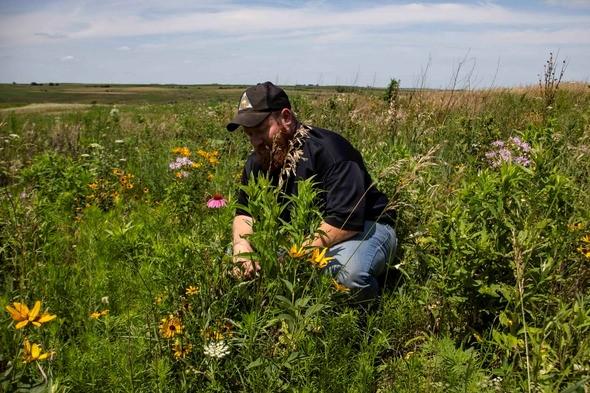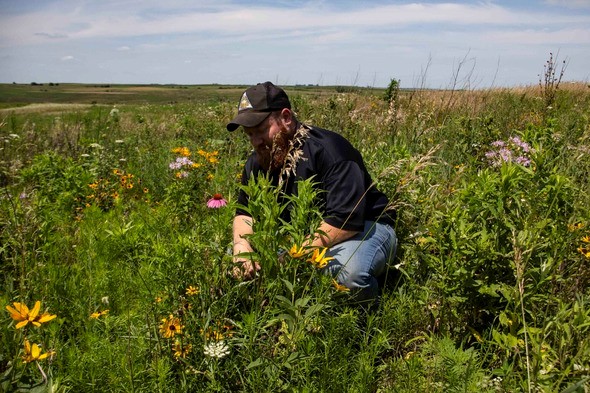
Xplor reconnects kids to nature and helps them find adventure in their own backyard. Free to residents of Missouri.


































Stay in Touch with MDC news, newsletters, events, and manage your subscription

Xplor reconnects kids to nature and helps them find adventure in their own backyard. Free to residents of Missouri.

A monthly publication about conservation in Missouri. Started in 1938, the printed magazine is free to residents of Missouri.


Maryville, Mo. – It’s early according to nature’s timetable, only the second growing season since the seeds went into the soil. But already prairie grasses and wildflowers are reclaiming sod on 600 acres of the Bilby Ranch Conservation Area in Nodaway County. The Missouri Department of Conservation (MDC) is restoring a tract on the area into the type of natural wildlife habitat that once covered most of northwest Missouri.
“Our goal is to restore a tallgrass prairie ecosystem, something that we don’t have a lot of acres,” said Phil Boyer, MDC wildlife biologist. “We want a contiguous grassland, uninterrupted. We’re trying to make it look like it might have been in the early 1800s.”
Purple coneflowers and yellow ox-eye sunflowers are blooming this summer on hills in the restoration tract. Warm-season grasses such as big bluestem, Indiangrass, and side oats grama are emerging. It will take years for the deep-rooted prairie plants to fully express their growth potential. But already they are providing overhead cover, insect hosts, and bare-ground openings at the base of plants that help ground-nesting birds like bobwhite quail. That change has already boosted the spring and fall quail counts at Bilby Ranch.
Prairie grasses and wildflowers in vast open grasslands were dominant in the region prior to the 1800s. They were interspersed in places with smaller open savannas and woodlands that were also friendly to grassland wildlife. The tallgrass prairie ecosystem created rich soils that now support the region’s predominate corn and soybean agricultural economy. Today, less than one-tenth of one present of Missouri’s historic prairies remain unplowed. Unplowed prairie remnants are especially scarce in the state’s deep-soil northwest region.
One remnant, MDC’s Little Tarkio Prairie in Holt County, is being used as the species model for the Bilby Ranch project. Restoring native grasslands provides a haven for wildlife and a destination for birders, wildlife watchers, and hunters.
The 5,110 Bilby Ranch property had a lake and several ponds when MDC acquired it 1987, but the rolling hills were mostly managed as crop fields with some acres in non-native brome grass pasture. Since then, MDC has managed more acres for wildlife habitat. Wildlife such as deer, turkey, and bobwhite quail need habitat that sustains them through the seasons and rearing young. Creatures such as songbirds and pollinators such as wild bees and butterflies need the same. They evolved in a tallgrass prairie ecosystem.
Restoring native plant diversity that resembles an original tallgrass prairie, however, is challenging. Starting in 2020, MDC began contracting with an area resident to remove trees that had encroached in fields and drainages. Historically, fire had kept trees from the prairies. An area farmer received a contract for haying brome fields that were to be converted to prairie plants. Local contractors were hired to spray herbicide to control unwanted, non-native cool season grasses in the prairie restoration target area.
In the autumn of 2021, Boyer and the MDC work team planted 30 different species of prairie forbs and four species of native warm-season grass into the treated acres south and west of Bilby Lake. Seedlings began growing in the 2022 growing season. Prairie plantings can take a few years to become established and dominant. Also, establishing diverse prairie species is more difficult and requires more management than simply establishing three or four prairie grasses for livestock forage. But this summer, Boyer got the proof that the prairie plants are sinking roots. The drooping yellow petals of the gray-headed coneflower and purple blooms of wild bergamot are among the showy wildflowers this summer.
“These are species that commonly show within a year,” Boyer said. “It shows we did well at getting our seed drilled at a good depth in the soil for germination.”
This autumn, prescribed burns will be used to boost the native prairie perennials. They evolved with fire. During winter they store nutrients in deep root systems that are protected from fire. The burns reduce competition from non-native plants.
The Bilby Lake prairie restoration will improve wildlife habitat but also give visitors a glimpse of what the region’s original landscape looked like. The tract will also demonstrate the growth potential for native grassland forage, which can play a profitable role in livestock grazing rotations. Visitors will pass by the prairie restoration area on the ridge road that leads to Bilby Lake off Missouri 46 highway, west of Maryville.
For more information about MDC’s Bilby Ranch Conservation Area, visit https://short.mdc.mo.gov/4mJ. To learn more about how MDC can help restore native prairie wildflowers and grasses on your property, visit https://short.mdc.mo.gov/4m4.